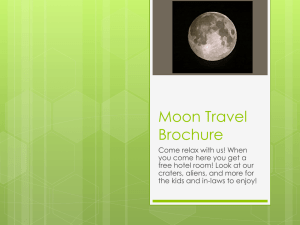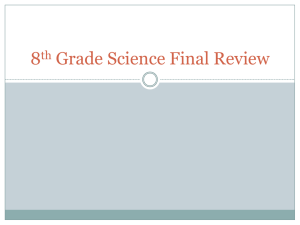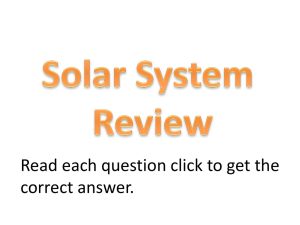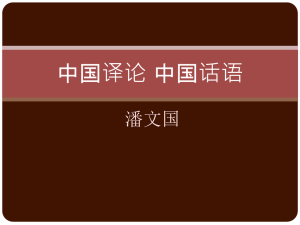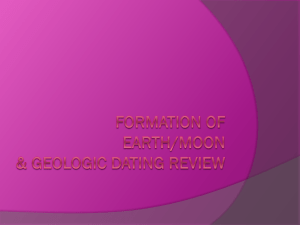Chapter 13: Earth, Moon, and Beyond
advertisement
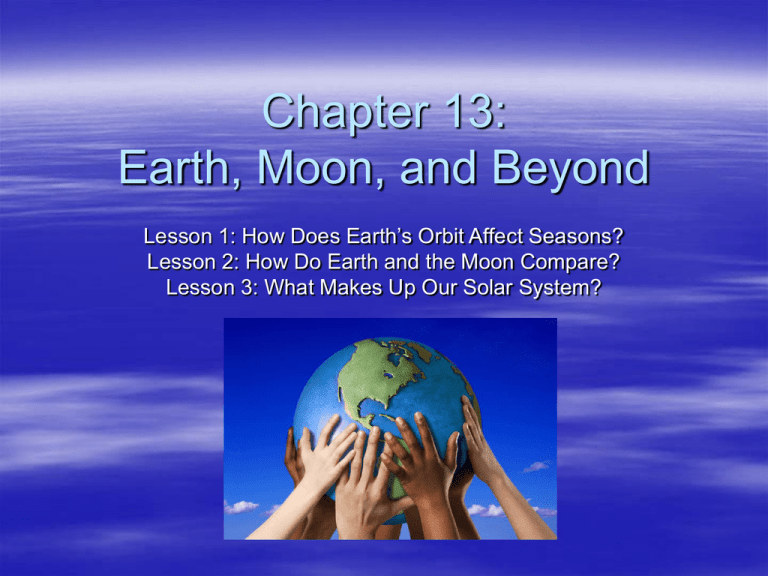
Chapter 13: Earth, Moon, and Beyond Lesson 1: How Does Earth’s Orbit Affect Seasons? Lesson 2: How Do Earth and the Moon Compare? Lesson 3: What Makes Up Our Solar System? Lesson 1: Vocabulary Sun: star at the center of our universe. rotate: to spin on an axis. axis: An imaginary line that passes through Earth’s center and its North and South poles. revolve: To travel in a closed path. orbit: The path one body takes in space as it revolves around another. equator: An imaginary line around Earth equally distant from North and South poles. Lesson 1 Each day the sun appears to rise, move across the sky, and set. But it’s really Earth that is moving. Not the sun. Earth rotates (spins) on its axis (imaginary line). Lesson 1 Sunrise and sunset happen at different times in different parts of the world. Long ago, each place used its own local system of time. This became confusing for people traveling long distances. In 1884, people set up a time system. Lesson 1 The new time system divided the world into time zones. All the places located in a specific time zone have the same time. Lesson 1 Most places on Earth have seasons. Summer is warmer and we have more hours of daylight. Winter is cooler and we have fewer hours of daylight. The seasons are caused by the tilt of Earth on its axis. Lesson 1 As Earth revolves around the sun, different parts of Earth are tilted toward Earth. When your part of Earth is tilted toward the sun, it is summer for you. The path that Earth moves on around the sun is called its orbit. Lesson 1 At the North and South poles, summer is 3 months of daylight with no darkness! Winter at the poles is 6 months of darkness! But even with 6 months of sunlight in the summer, it is still very cold in the South Pole. This is because the sun’s rays to the South Pole are indirect rays. Lesson 1 At the equator, it is warm all year long. Days and nights are about 12 hours each. All year long. Areas near the equator receive direct rays all year through. Lesson 2 : Vocabulary Moon: Any natural body that revolves around a planet. Craters: Large, bowl-shaped areas on the moon’s surface. Eclipse: Happens when one body in space blocks sunlight from another. Refraction: The bending of light from the sun. Moon phases: The different shapes of the moon. Lesson 2: How Do Earth and Moon Compare? The Moon and Earth: Earth’s moon is a natural body that revolved around the Earth. Earth and moon are similar because they are both rocky and dense, they both have craters, and they are both made of similar elements. Lesson 2: How Do Earth and Moon Compare? There are many ways in which the Earth and moon are quite different as well. The moon is much smaller and has less gravity. The moon does not have much of an atmosphere or liquid water. The astronauts who walked on the moon had to wear space suits so that they could breathe. There is also no life on the moon. Lesson 2: How Do Earth and Moon Compare? Phases of the Moon: On some nights, the moon seems round while other nights it look like a half circle or sliver. Both the moon and Earth are always moving which make them look different. The moon does not make its own light and only reflects lights from the sun. As the moon orbits Earth, different parts of it face the sun. This is what causes the moon to appear in different shapes (moon phases). Lesson 2: How Do Earth and Moon Compare? Eclipses: Sometimes one body in space blocks the sunlight from another body. When the moon is between Earth and the sun, it makes a shadow on Earth. This is called a solar eclipse. When a full moon passes through Earth’s shadow, it makes a lunar eclipse. Earth blocks the sun’s light from reaching the moon. During a lunar eclipse, the moon looks red which is caused by refraction. Refraction is the bending of sun’s light. Lesson 3: Vocabulary Star: is a very large ball of hot, glowing gases in space. Solar system: Is made up of a star (sun) and the objects that orbit the star. Constellation: A group of stars that appears to form a picture. Universe: Is everything that exists. Galaxies: Groups of stars, dust, and gas, in the universe. Planets: Bodies that revolve around the sun. Lesson 3: What Makes Up Our Solar System? The Sun and Other Stars: The sun is a star at the center of our solar system. The sun is a million times larger than Earth. The sun is only an averaged sized star. At night you can see groups of stars. Sometimes they form pictures or constellations. Lesson 3: What Makes Up Our Solar System? The Inner Planets: Our solar systems has 8 planets. A planet revolves around a star (sun). The four planets closest to the sun are the inner planets. They are: Mercury, Venus, Earth, and Mars. Lesson 3: What Makes Up Our Solar System? The Outer Planets: There are 4 outer planets. They are: Jupiter, Saturn, Uranus, and Neptune. These are called gas giants because they are made of gases like hydrogen and helium. Jupiter is the largest planet in our solar system. A huge storm on Jupiter has lasted more than 300 years and is called the “Red Spot”. All the gas giants have rings around them and moons orbiting them. The rings are made of ice, dust, rocks, and frozen gas. Lesson 3: What Makes Up Our Solar System? Beyond the Solar System: The universe includes everything that exists. Within the universe there are 1 billion galaxies that exist. A galaxy is gas, dust, and a group of stars. Our galaxy, the Milky Way, is spiral shaped.





